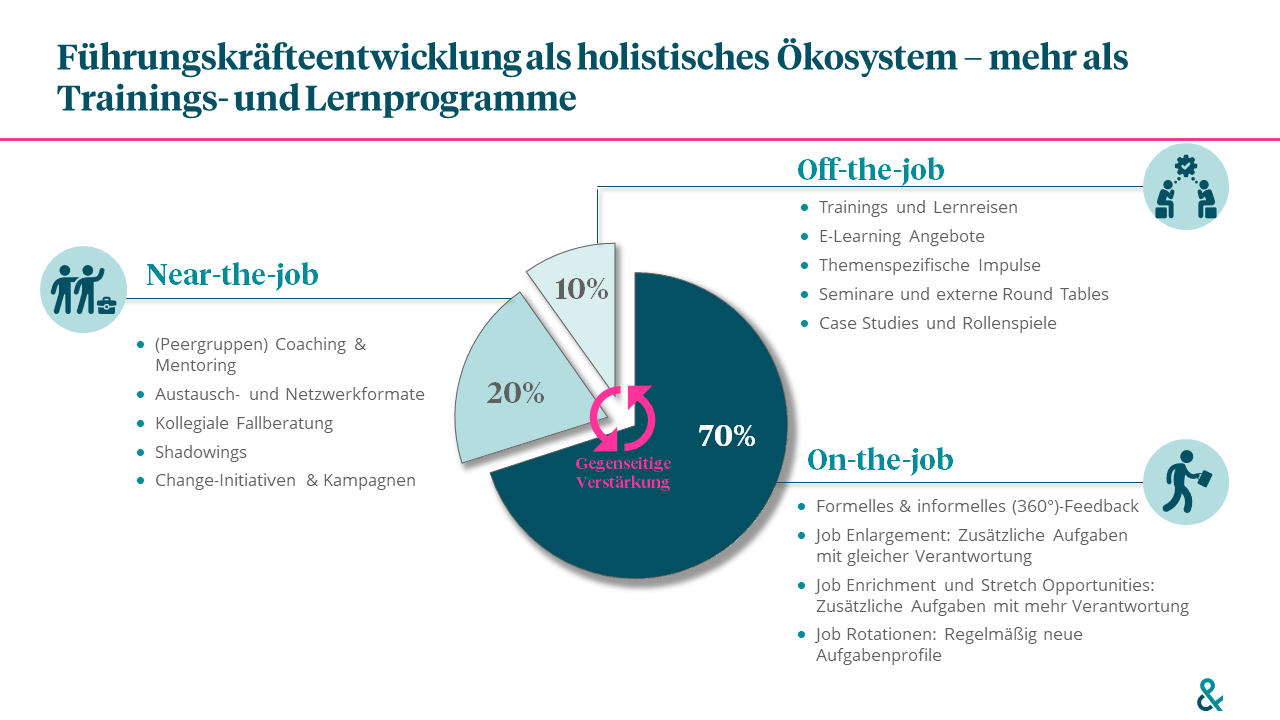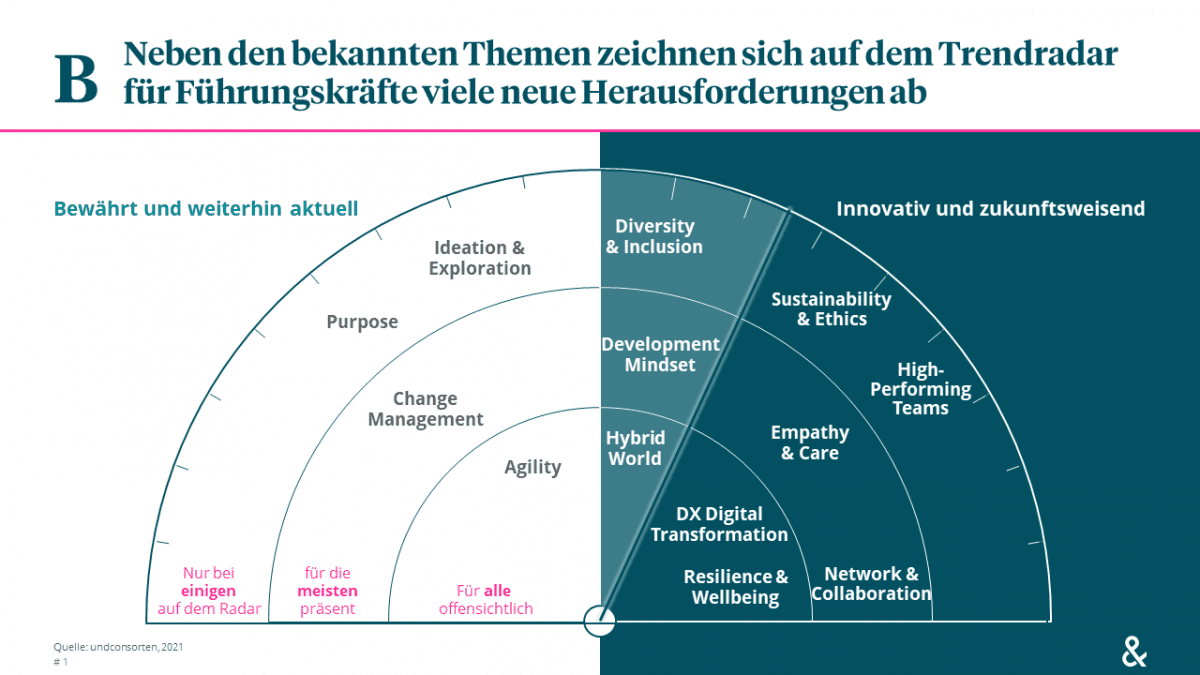
Leadership development: concept, methods, objectives and practical tips
What is leadership development?
Leadership development is the targeted promotion of skills, behaviours and attitudes of managers and a sub-area of personnel development. The aim of management development is to create a framework that enables managers to make their maximum contribution to the company's success.
Why is leadership development important and how does it work?
Numerous studies have shown the strong influence of leadership on the performance of a company, both directly in day-to-day work with employees and indirectly as a catalyst for strategic initiatives. It is also relevant for the transformation of companies, their business models, organisations and cultures. Continuous work on leadership in the form of leadership development is therefore taking centre stage in many companies. But how does leadership development work?
If you want to answer this question in an impact-oriented way, you would have to specify it as follows: "What support do managers need in order to master the challenges of the VUCA world and transform organisations sustainably?"
Firstly, there is the empowerment of managers through (customised) training and management development programmes (often referred to as "learning journeys"). However, this is only one aspect of leadership development. It makes more sense to take a comprehensive approach to the topic. Instead of training individual managers, it is more effective to develop an ecosystem to improve the culture of leadership and cooperation throughout the entire organisation. A holistic approach that combines people development and organisational development increases the impact of leadership as a catalyst for sustainable business success rooted in a strong corporate culture.
In addition to training and learning programmes, holistic leadership development includes other elements such as
- E-learning platforms with curated collections of learning content for self-directed learning
- Feedback, coaching and mentoring
- Development-orientated tasks and projects
- Exchange/networking formats
- Change initiatives and campaigns
- HR tools/processes such as recruiting, onboarding, placement, career paths, talent and performance management
These elements combine development opportunities on/near/off the job. Their interaction works towards improving leadership attitude and behaviour. In this way, they reinforce each other's effects - as in an ecosystem.

But before delving into the question of how (how to develop leaders), the question of what (expectations of leadership) should be answered.
What are the requirements for effective leadership?
You can find answers to this question in numerous leadership concepts, which are also subject to certain fashions. Examples of leadership concepts that have been on everyone's lips in recent years include ambidextrous leadership, transformational leadership, agile leadership and servant leadership.
Some, such as agile leadership, are present in the majority of companies, while others, such as sustainable and ethical leadership, are only pursued in isolated cases. In addition to the various leadership concepts, more or less established trends are also currently being discussed. While trends such as change management are anything but innovative and are only supplemented by new facets, if at all, trends can also be observed that have only been on the market for a relatively short time. For example, the topic of hybrid working environments only became prominent during the pandemic. There are topics such as diversity and inclusion that are still in the early stages of being addressed, even if they have been virulent for some time.

What leadership attitudes and leadership competences do managers need in order to serve these trends? Some competences are still important, such as
- Constant self-reflection and acting as a role model
- Making fundamental decisions
- Delegating responsibilities (instead of tasks)
- Developing employees
- Driving change through a balance between top-down and bottom-up elements
Other leadership skills have been added or are now more strongly emphasised. These include, for example
- Dealing with changes in status and transferring traditional management tasks to third parties
- Creating a customer- and employee-centred vision and purpose and communicating these in a motivating way
- Creating entrepreneurial and creative environments
- Dealing with various interface partners and leadership in the ecosystem
- Curating and developing entire teams
But how can leadership culture be improved effectively and quickly in times of scarce human and financial resources?
The development of managers
Effective leadership development essentially consists of four building blocks:
- Leadership principles: A common understanding, shared within the organisation, of the requirements for good leadership - and therefore the foundation and orientation for leadership development; leadership principles are alternatively referred to as leadership understanding, leadership model, leadership competencies, guiding principles or leadership essentials and are concretised with the help of behavioural examples (or behavioural anchors).
- Leadership architecture as an overall offer for leadership development: A tailored, business-oriented and coherent portfolio for managers that pays into the desired leadership behaviour (as expressed in leadership principles) and at the same time addresses the individual needs of managers; elements (on/near/off-the-job) include, as already described in the first section, in addition to training/programmes/learning journeys, for example offers for e-learning, digital engagement platforms, feedback, executive coaching & mentoring offers and change formats such as leadership conferences or cascade workshops. Furthermore, relevant interfaces to HR instruments (recruiting, placement, talent & performance management, etc.) are designed to increase the effectiveness of the leadership development programme.
- Leadership development programme: core of the leadership architecture for designing the individual learning journeys of managers; these programmes are typically designed in a blended learning format and address a leadership target group such as lower/middle/upper management or a leadership topic such as digital transformation or resilient leadership; they empower on three levels: Knowledge, attitudes, behaviour.
- Organisational framework conditions: The prerequisites for exploiting the full potential of systematic leadership development, components include, for example, budgets and IT infrastructure for learning (LXP, LMS, apps, etc.), regulations such as guidelines for learning, trainer resources, HR resources incl. skills for leadership development, general organisational structure (e.g. management spans, hierarchical structures), organisational structure (e.g. management and leadership development) and organisational structure. Many of these framework conditions relate to the "may" or "can" dimension (in the sense of availability), while the overall architecture is based on the "can" (in the sense of skills) and "want" dimensions.
Our overview shows you typical procedures and tips on what is important in the four elements of effective leadership development:
These approaches and methods have now become established in practice and form the canon of leadership development. We have also seen some interesting trends in the field of leadership development in recent years.
Trends in management development
Leadership development must produce high-performance teams instead of superheroes.
In most situations, a diverse leadership team makes all the difference. In view of the increasing complexity of tasks and leadership, team composition, development and involvement are becoming increasingly important. Therefore, one of the most relevant tasks of the future leader is to work together in a high-performance leadership team.
Leadership development is individualised and must take into account the decisive moments in a manager's life cycle.
This includes situations such as the first management role/onboarding, the first (critical) employee appraisals and the first time representing one's own company in public. The aim of management development must be to support managers in their individual challenges and to accompany them.
Leadership development must ensure that different leadership roles can coexist in an organisation.
In addition to the traditional general manager, many organisations now have new roles such as agile coach, architect, people manager or platform owner, who take on certain leadership tasks. Occasionally, managers take on different roles depending on the context and situation.
Leadership development requires real teamwork between business and human resources.
Without a strong role model from the business, HR can hardly be effective. Most leadership development takes place in the workplace and requires direct reports, colleagues and senior managers as teachers and mentors. In the future, the modern HR department will be the coach of leaders and teams, the challenger of top management and the owner of the leadership development process.
The leadership development function of the future is not a jack-of-all-trades.
The internal goal of leadership development is to be a lean and powerful background function that provides the stage for the business to take the lead. In addition to a clear focus on leadership, providing scalable and cost-effective leadership development offerings that reach executives is the key success factor for the efficiency and effectiveness of the function.
What can leadership development look like in your organisation? A case study.
One example of a holistic approach to leadership development from our practice is that of an international automotive supplier. This company was on the cusp of a strategic realignment and transformation with the aim of successfully shaping trends such as e-mobility and Industry 4.0. In order to enable managers to master the transformation, play an active role in shaping it and mobilise employees, we supported management development in several stages:
Development of leadership principles
The project began with the Executive Board's realisation that every single one of the more than 10,000 managers should help shape the transformation and be empowered to do so. From the Executive Board to the team leaders in production - the goal was a shared understanding of leadership that would serve as a compass for leadership development for the transformation. Common leadership principles were needed.
To develop leadership principles, a comprehensive diagnosis of the existing leadership culture was first initiated in order to recognise strengths and development needs, but also to understand local characteristics:
- Online survey and workshops with over 430 participants from all regions, divisions and functions
- Individual interviews with all members of the Executive Board
- Workshops with employee representatives
The method of broad participation in the analysis phase before the actual start of the project paid off: Throughout the project, managers were highly committed and motivated. The analysis phase also clearly showed the strengths and weaknesses with regard to the prevailing understanding of leadership.
After the analysis phase, the results were discussed further with various stakeholder groups, mirrored and summarised, always with the close support of the Executive Board and top management.
This resulted in six leadership principles, each of which was specified and described in terms of action by five underlying leadership behaviours.
During the implementation phase, the leadership principles were not only publicised, but also integrated into everyday life to guide action. The measures included
- Utilisation of classic and modern communication channels (brochures, communication materials, videos, company website, social media, etc.)
- Global leadership roadshow
- Active involvement of all managers worldwide and implementation of culture-shaping elements (workshops on the leadership principles of all Management Board members with their N-1 managers to reflect on leadership behaviour and select a leadership principle where an improvement would advance the respective business priorities)
- Global cascade of these workshops to the next two management levels
- Integration of check-ins, retros, etc. on leadership behaviour into existing management routines
- Successive adaptation of all relevant HR tools and processes
Since then, tens of thousands of employees have been asked in regular Pulse Surveys how they perceive leadership in the company. Progress is thus clearly demonstrable - and targeted adjustments can be made.
Establishing an overall architecture and management development programmes for empowerment
Particularly at the beginning of the transformation, it was important to equip managers with the necessary mindset, skills and toolset for the transformation and to anchor the new leadership principles in managers' day-to-day work with targeted support. To this end, we revised the existing overall architecture for leadership development in three steps:
- Learning architecture for leadership development
- Inventory of existing architecture and programmes
- Definition of typical leadership challenges along the existing target groups and management levels in the organisation
- Development of an overarching leadership learning architecture to structure the leadership and management programmes
- Programme landscape for leadership development
- Description of the central role expectations, taking into account the different leadership challenges per level along the leadership principles
- Comparison of the current programme landscape with the developed target image and derivation of additions and adjustments
- Proposed procedure for the effective implementation of the learning objectives and leadership essentials in the entire programme offering for leadership
- Concept for a leadership programme
- Selection of a target group based on relevant criteria (including learning needs and relevance for establishing a new leadership culture)
- Creation of a concept for a leadership development programme as a flagship offering:
- Cornerstones, content objectives and "story" for the programme
- Outline of modular learning interventions and formats (on-, near- and off-the-job)
- Support in the selection of providers
Overall, the leadership development project ensured that managers were given an effective framework for shaping the transformation. The developed components of the management development programme are also re-evaluated at regular intervals and adapted if necessary. This is because the framework conditions and requirements for leadership development change along with the challenges of the business.
Seven tips for successful leadership development
The example described is illustrative of our management development consulting projects. At the same time, each project is individual and must aim to be tailored to the specific needs of the organisation. However, in our experience, there are a number of tips and success factors that apply to all successful leadership development programmes:
- Holistic approach ("more than programmes"): A holistic architecture is required for leadership development to have a lasting impact. Supplementary questions beyond the programme question include What accompanying change management initiatives are needed? How are the programmes embedded in the eLearning platform? Which HR tools have an impact on improving leadership attitudes and behaviour?
- Orientation towards business success: Work on leadership should not be an end in itself, but should be orientated towards its impact on the business. The content of leadership development (e.g. leadership principles, training topics) should therefore be dovetailed with business content (e.g. How can leadership support the digital transformation? How can leadership mobilise our employees?)
- Focus on managers: To ensure that managers actually make use of the offers, the learners, i.e. the managers addressed, should be at the forefront of the content and formats (e.g. How can I quickly tackle my acute leadership challenge? How can I combine learning with day-to-day business?) Practical examples, exchange and collegial case counselling, case studies, projects and toolboxes for pragmatic use in everyday life have proven their worth here.
- Scaling via digitalisation and multipliers: In times of scarce resources, it is more important than ever to support and scale leadership development. This can be done via digital broadband formats or via empowered leadership ambassadors from HR and the business.
- Activating the target group: The best offer for managers is useless if it is not accepted. (There can be many reasons for this, including a lack of awareness of the offer). It is therefore worth thinking about activation, e.g. via marketing and change measures, for the end product developed.
- Commitment and role model function of the top team: A sustainable improvement in the leadership culture can only be achieved if the top team positions leadership as a top priority both internally and externally, works continuously on itself and acts as a role model. This also means that companies invest holistically and over several years in the development of managers and that lazy compromises become rarer in practice.
- Measuring success, consequences and continuous improvement: How do we measure whether our leadership development is successful? This requires defined KPIs and qualitative indicators at the input, output and outcome levels. These can be aimed at manager satisfaction, changes in behaviour (of managers and employees) or measurable influence on the business.
If we can support you with leadership development, please contact Nadeshda Kreya, leadership development expert in our Berlin office.
Interested in other topics in our Leadership consulting area? Find out more.





